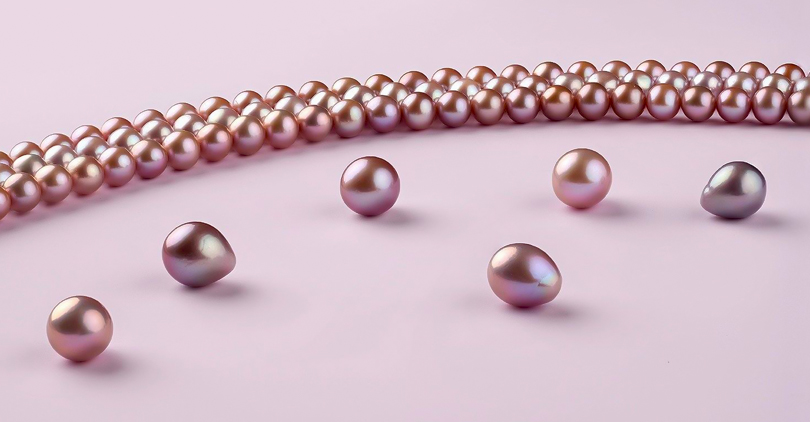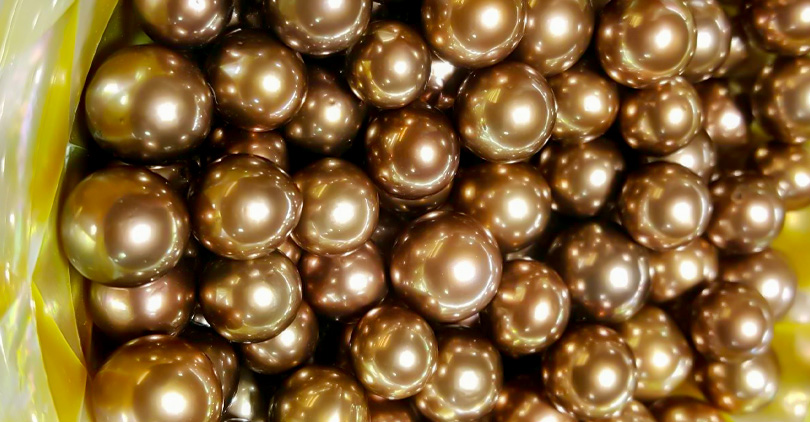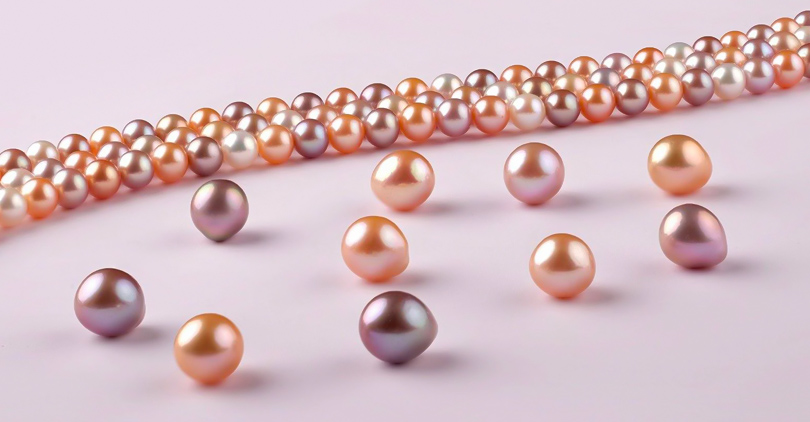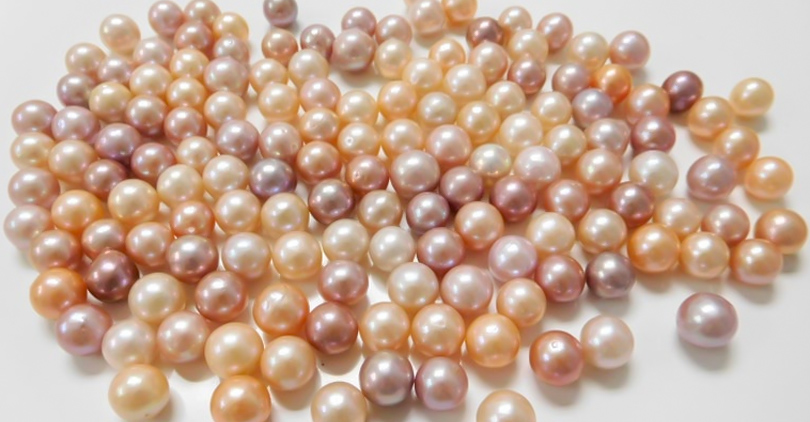Understanding Pearl Colors: How Do Oysters Make Colored Pearls?


Prepare to have your mind blown if you assume only white pearls occur naturally! As a jewelry expert, I've picked up countless pearl facts through my work in jewelry stores, but one of the most fascinating aspects is how oysters can create such a variety of colors.
Whether you're talking about delicate blues and pinks or dazzling golds and greens, these vibrant hues make any piece of jewelry even more captivating.
While many might think colored pearls are something produced only with human intervention, the reality is much more mesmerizing. Oysters – those amazing sea creatures – can actually create them on their own in stunning shades all along.
But how? Let's dive into this magical world together as we uncover exactly what makes different colors happen (hint: it involves secrets Mother Nature herself keeps from us).
How Do Oysters Make Colored Pearls?

Curious about the secret behind oysters' ability to produce such a wonderful array of colored pearls? Prepare yourself for an exploration of the enchanting way these sea creatures can create everything from delicate, pale hues to bold and bright shades.
What Contributes to a Pearl's Color?
When it comes to comprehending pearl hues, there are three key things to think about. Firstly, the type of oyster they come from has a big impact – Akoya pearls tend towards pinkish tones, while Tahitian ones lean more green.
Secondly, how many layers of nacre (mother-of-pearl) have built up around each bead will affect how rich its color looks – more is usually better.
Finally, the thickness of those layers also affects how light passes through them. This determines whether your jewelry shimmers as if lit from within (aka ‘orient’) or just glows nicely on top!
Combine all these variables, and you end up with nature’s amazing palette: colored pearls galore!
What Is Mother-of-Pearl (Nacre)?

Nacre, also called Mother-of-Pearl, is a mesmerizing substance that enhances pearls' loveliness and charm.
Picture something transparent like glass yet more stunningly lustrous. Oysters produce this organic marvel in wafer-thin coatings, which build up over time to compose a radiant work of art: a pearl.
So, how exactly do oysters create pearls in different colors? The secret is nacre – specifically, the number of layers of this substance that coat each pearl. Thicker nacre results in richer hues since light reflecting off multiple layers produces a more intense effect.

Imagine a shining jewel with vibrant shades: this is all down to lots of nacre piled up on top of itself. On the other hand, if there's hardly any overlap between these sheets, then things might appear rather pale or even slightly murky by comparison – lacking depth, as it were.
When you see an iridescent shimmering surface, what you're really looking at are many thin coatings stacked together. They bounce back differing wavelengths, creating something altogether special!
How Do Oysters Make Pearls?

The fascinating process of pearl formation begins when a tiny foreign object enters an oyster and reaches its soft inner tissue. The mollusk senses the invader and responds by secreting nacre to protect itself.
Over time, layer upon layer of this lustrous substance covers the irritant until, eventually, it has been transformed into a beautiful pearl.
But how is it that oysters make pearls in different colors? The answer lies in their ability to incorporate trace amounts of various elements into the nacre they produce.
When these substances combine with calcium carbonate – the main ingredient in nacre – they give it different hues.
In other words, nature herself acts like a resident artist, adding pigments that help determine what color each resulting pearl will be so that anyone who sees one can appreciate its beauty even more fully.
How Do Oysters Create Different Color Pearls?

The ocean's oysters are true maestros when it comes to crafting a dazzling array of pearls in various hues. But what makes these colors happen? The answer lies within aragonite platelets.
These fragile, nearly see-through crystals form layers inside the pearl and help create its amazing shades. When white light enters a pearl's surface, these platelets go to work, bouncing those rays around like pinballs so that they eventually come back out toward our eyes.
They ricochet through different levels, much like you'd see when peeking into a tube filled with mirrored angles reflecting morsels at every turn. This beam reveals breathtaking tones: fiery oranges, majestic crimsons, emerald greens, sunny yellows, velvety purples, or tranquil blues.
It's almost as if Mother Nature herself became an artist effortlessly blending pigments to make radiant heirlooms capable of not only capturing one's heart but also stimulating minds everywhere.
The Breakdown for Every Color Pearl

When it comes to colored pearls, having an understanding of what each hue is made up of can be very important. Here's a quick look at the world of pearl colors:
White Pearls

The elegance and purity of white pearls cannot be denied! Whatever type you choose – White South Sea, White Akoya, or White Freshwater – there's a shade to suit your taste. But what sets them apart is the stunning overtones they possess.
Imagine rose, delicately tinting white pearls pink and adding an extra touch of sophistication, ivory that calls to mind French Vanilla ice cream, or silver for the purest white imaginable.
In sizes ranging from 1. 0mm-2. 0mm seed pearls all the way up to 20. 0mm behemoths (perfect for those who crave larger-than-life jewels), this gemstone has something special just waiting for everyone.
It's little wonder brides favor them so highly – their association with gracefulness makes them perfect adornments on any bride's special day!
Check these pieces:
•11.5-12.0mm White Freshwater Pearl Sweetheart Sway Earrings in 18K Gold - AAAA Quality
•10.0-11.0mm White South Sea Pearl Aurelia Ring in 18K Gold - AAAAA Quality
Black Pearls

Enigmatic and captivating, there's nothing quite like a black pearl! While Black Akoya and Black Freshwater pearls are available, they undergo color treatment (often dyeing) to achieve their deeper shades.
As such, among the natural-colored options are black Tahitian pearls from French Polynesia and Sea of Cortez pearls from Guyamas, Mexico.
What sets black pearls apart is truly something special: overtones that range from Peacock — a mix of greens, golds, and roses — to entrancing Green or Blue-Green hues. And it doesn't stop there – you may also spy enticing hints of Rose, Silver, Copper, or Aquamarine on these darkly-hued gems.
Sizes can vary from 8mm up to around 16mm – making them an attention-grabbing choice for sure!
Check these pieces:
•9.0-10.0mm Black Tahitian Pearl Stud Earrings in 18K Gold - AAAA Quality
•9.0-10.0mm Tahitian Black Pearl and Diamond Halo Ring
Blue Pearls

The ocean is home to an alluring and scarce treasure called the blue pearl. Its mesmerizing shades can be seen in rare types like the blue Akoya, silver-blue white South Sea, Tahitian, or Sea of Cortez pearls – each boasting a unique beauty.
And let's not forget overtones! Blue Akoyas offer intense reflections of blues such as aquamarine, rose, or violet that will take your breath away!
But if it's something different you seek, then fear not because these rare gems also come with greens (varying intensities), teals, and cerulean—some even hint here & there at violets, too.
Size ranges cater to every taste bud: some prefer smaller sizes while others crave larger ones – whatever tickles your fancy!
Check these pieces:
•10.0-11.0mm Baroque Blue South Sea Pearl Rain Drop Earrings in 18K Gold - AAA Quality
•14.5-15.0mm Starry Blue Mabe Pearl Removable Pendant in 18K Gold - AAAAA Quality
Golden Pearls

Golden pearls – the ultimate symbol of wealth and prosperity. They come in an astonishing variety of shades, giving any jewelry collection a touch of pure luxury.
Choose from dazzling neutral gold (yellow), silver, rose, green/bronze, or champagne overtones to find the one that suits you best. Each has its special radiance and appeal.
These extraordinary gems are available in sizes ranging from 9mm right up to an impressive 16mm or larger – perfect if you want your elegance on a grand scale!
It's no surprise that golden pearls feature heavily in legends as they're thought to bring huge amounts of both money and luck.
Check these pieces:
•10.0-11.0mm Golden South Sea Pearl Daisy Pine Pendant in 18K Gold - AAAA Quality
•11.0-12.0mm Golden South Sea Pearl Diamond M Earrings in 18K Gold - AAAA Quality
Pink Pearls

If you adore pink, then prepare to become entranced by the magical world of pink pearls. These gems have different enchanting shades that are simply captivating.
From serene aquamarine hues to lively greens and rich golds – pink pearls really show off their colors!
You can pick from a range of sizes, too: whether you like smaller pearls (4.0-12.0mm) or want something bigger (14.0-16.0mm Edison pearls), there's an option for everyone.
Classic yellow gold is always a great choice when it comes to pairing jewelry with pretty pinks. It just seems to make them even more beautiful somehow.
Check these pieces:
•12.0-15.0mm Peach Freshwater Pearl Necklace - AAAA Quality
•Orange-Pink Mabe Pearl Ring- AAA Quality
Lavender Pearls

Lavender pearls are incredibly beautiful, with gentle shades that create a feeling of peace and tranquility. These freshwater pearls have an amazing range of colors. Cool tones such as aquamarine or green might be seen in some lights, while others could show hints of gold or rose.
The most common sizes for lavender freshwater are between 4-12mm. Most jewelry shops stock strands within the range of 6-9. 5mm.
However, there are also huge ones (13-16mm) available now. They are called "Edison" because they're made by bead nucleating process rather than naturally forming inside oysters like other types do
Check these pieces:
•5.5-6.0mm Lavender Freshwater Pearl Bracelet - AAAA Quality
•9.0-12.0mm Lavender Freshwater Pearl Necklace - AAAA Quality
Chocolate Pearls

Step into the exquisite world of chocolate pearls and let your senses be captivated. With several options available, such as color-enhanced Chocolate Tahitians, naturally colored Chocolate Tahitians, and dyed Chocolate Freshwaters, these gems are a sight to behold.
They come in an array of enticing shades that range from shimmering gold to soft rose, with hints of green/bronze playing across deep dark chocolate or milk chocolate body tones.
These pearls make statements at sizes between 9.0mm and 14.0mm. The average size is closer to 10-12mm.
Multi-Colored Pearls

For those in search of multi-colored pearls, the choices are as plentiful and varied as nature itself. From breathtaking Tahitians and radiant South Sea pearls to beguiling Freshwaters, these gems offer something for every taste – and budget.
Some measure 6.0-7. 0mm; others exceed an impressive 15.0-16.0mm or more! They cater to all tastes and styles in between.
Here’s a fun fact: multi-color South Sea pearl bead necklaces are affectionately called “Pelosi Pearls” after someone who loved them enough for this distinction – adding another layer of intrigue to their overall story!!
Conclusion

The process of how oysters make colored pearls is captivating. Pearls come in many colors, and it's amazing to learn why. The kind of oyster, the number of layers of shiny stuff inside (nacre), and the way light bounces off them all help create different colors.
Looking at pink pearls makes you feel calm because they are soft-colored. But looking at black Tahitian pearls can be exciting because they seem deep, like an ocean trench!
Every color is interesting for its reason. Next time you see a pearl with one particular hue, ask yourself what story might lie behind that shade. These facts remind us just how wonderful nature is!
FAQs

Do colored pearls occur naturally?
Undoubtedly, the reason why pearls have different colors is because of differences in the species of oysters that produce them, the number of layers of nacre that are on them, and how thick those layers are.
Does a pearl's color affect its cost?
If we talk about pearls, their value can be calculated by the color that is not common. It means those that are a bit unusual or even very rare yet amazing attract higher prices comparatively.
How do you know if there is a pearl in an oyster?
Professionals use various techniques like X-rays or surgeries to determine if an oyster has a pearl.
Do oysters die when you take the pearl?
If pearls are taken out of oysters kindly, the oysters may stay alive. They may even make more pearls later on.








1 Comment(s)
Beautiful
Leave a Comment